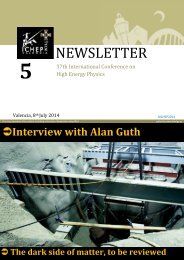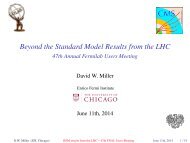PW_mar13_sample_issue
PW_mar13_sample_issue
PW_mar13_sample_issue
You also want an ePaper? Increase the reach of your titles
YUMPU automatically turns print PDFs into web optimized ePapers that Google loves.
physicsworld.com<br />
Quantum frontiers: Weak measurement<br />
Strength in weakness Obtained through the principle of weak measurement, this 3D plot shows where a quantum particle is most likely to be<br />
found as it passes through a Young’s double-slit apparatus and exhibits wave-like behaviour. The lines overlaid on top of the 3D surface are<br />
the experimentally reconstructed average paths that the particles take through the experiment.<br />
way. If we deliberately allow the uncertainty in the<br />
initial pointer position (and hence the uncertainty<br />
in the measurement) to be large, then although no<br />
individual measurement on a single pointer will yield<br />
much information, the disturbance arising from a<br />
measurement can be made as small as desired.<br />
At first sight, extracting only a tiny bit of information<br />
from a measurement might seem to be a strange<br />
thing to do. But as is well known to anyone who has<br />
spent hours taking data in an undergraduate laboratory<br />
– not to mention months or years at a place<br />
like CERN – a large uncertainty on an individual<br />
measurement is not necessarily a problem. By simply<br />
averaging over enough trials, one can establish<br />
as precise a measure as one has patience for; at least<br />
until systematic errors come to dominate. Aharonov<br />
called this a weak measurement because the coupling<br />
between the system and the pointer is assumed<br />
to be too weak for us to resolve how much the pointer<br />
shifts by on just a single trial.<br />
Under normal circumstances, the result of a weak<br />
measurement – the average shift of pointers that<br />
have interacted with many identically prepared systems<br />
– is exactly the same as the result of a traditional<br />
or “strong” measurement. It is, in other words, the<br />
“expectation value” we are all taught to calculate<br />
when we learn quantum theory. However, the low<br />
strength of the measurement offers a whole new set<br />
of insights into the quantum world by providing us<br />
with a clear operational way to talk about what systems<br />
are doing between measurements. This can be<br />
understood by considering a protocol known as postselection<br />
(see figure 1).<br />
To see what post-selection is all about, let’s consider<br />
a simple experiment. Suppose we start at time<br />
t = 0 by placing some electrons as precisely as we can<br />
at position x = 0. We know from Heisenberg’s uncertainty<br />
principle that their velocity will be enormously<br />
uncertain, so we will have essentially no idea where<br />
an electron will be after, say, 1 second. But if we place<br />
a detector 1 metre away at x = 1, any given electron<br />
will always have some chance of being spotted there<br />
at t = 1 because the wavepacket has spread out over<br />
all space. However, when we make a measurement<br />
of where the wavepacket is, it may collapse to be at<br />
x = 1, or to be elsewhere.<br />
Now suppose we take one of these electrons that<br />
appeared at x = 1, which is what we mean by postselection,<br />
and ask ourselves how fast it had been travelling.<br />
Anyone with common sense would say that it<br />
must have been going at about 1 m/s, since it got from<br />
x = 0 to x = 1 in 1 s. Yet anyone well trained in quantum<br />
mechanics knows the rules: we cannot know the<br />
position and the velocity simultaneously, and the electron<br />
did not follow any specific trajectory from x = 0<br />
to x = 1. And since we never directly measured the<br />
velocity, we have no right to ask what that value was.<br />
To see why Bohr’s followers would not accept the<br />
seemingly logical conclusion that the electron had<br />
As anyone who has spent hours<br />
taking data in an undergraduate<br />
laboratory knows, a large uncertainty<br />
on an individual measurement is not<br />
necessarily a problem<br />
Physics World March 2013 37<br />
Krister Shalm and Boris Braverman








